2014 FIFA Dünya Kupası’na Katılan Takımların Faktör Analizi ile Sıralanması
2014 Dünya Kupası, Faktör Analizi, Spor İstatistikleri, Sıralama
The Ranking of the Participating Teams in 2014 FIFA World Cup by Factor Analysis
2014 World Cup, Factor Analysis, Sport Statistics, Ranking,
___
- Albayrak, A. S. (2005). Türkiye’de İllerin Sosyoekonomik Gelişmişlik Düzeylerinin Çok Değişkenli İstatistik Yöntemlerle İncelenmesi.Doktora Tezi.İstanbul Üniversitesi Sosyal Bilimler Enstitüsü.İstanbul
- Alpar, C. R. (2013). Çok Değişkenli İstatistiksel Yöntemler (4th ed.). Ankara: Detay Yayıncılık.
- Alpar, C. R. (2014). Uygulamalı İstatistik ve Geçerlik-Güvenilirlik (3rd ed.). Ankara: Detay Yayıncılık.
- Bohlmann, H. R., & Heerden, J. H. Van. (2008). Predicting the economic impact of the 2010 FIFA World Cup on South Africa. International Journal of Sport Management and Marketing, 3(4), 383. http://doi.org/10.1504/IJSMM.2008.017214
- Cengiz, D., & Kılınç, B. (2007). Faktör Analizi ile 2006 Dünya Kupasi’na Katılan Takımların Sıralamasının Belirlenmesi. Marmara Üniversitesi İ.İ.B.F. Dergisi, 13(2), 351–370.
- Conchas, M. (2014). Research possibilities for the 2014 FIFA World Cup in Brazil. Soccer & Society, 15(January), 167–174. http://doi.org/10.1080/14660970.2013.828600
- Furuichi, S., & Hino, H. (2011). Mathematical analyses of 2010 FIFA world cup. Applied Mathematics&Information Sciences, 5(2), 205–219.
- Hair, J. F., Anderson, R. L., & Tatham, W. C. B. (1998). Multivariate Data Analysis. New Jersey: Prentice Hall.
- Kavetsos, G., & Szymanski, S. (2010). National well-being and international sports events. Journal of Economic Psychology, 31(2), 158–171. http://doi.org/10.1016/j.joep.2009.11.005
- Kim, H.-C., Kwon, O., & Li, K.-J. (2011). Spatial and spatiotemporal analysis of soccer. 19th ACM SIGSPATIAL International Conference on Advances in Geographic Information Systems, 385 –388. http://doi.org/10.1145/2093973.2094029
- Korkmaz, S., Goksuluk, D., & Zararsiz, G. (2014). MVN: An R Package for Assessing Multivariate Normality. The R Journal, 6(2), 151–162. Li, Y., & Li, S. (2014). SAS factor analysis-based world cup football team comprehensive strength evaluation research, Journal of Chemical and Pharmaceutical Research, 6(6), 2412– 2419.
- Papanikos, G. T. (2015). Economic, population and political determinants of the 2014 World Cup match results. Soccer & Society, 0970(July), 1–17. http://doi.org/10.1080/14660970.2015.1067799
- Stone, C., & Rod, M. (2014). Unfair play in World Cup qualification? An analysis of the 1998– 2010 FIFA World Cup performances and the bias in the allocation of tournament berths.
- Soccer & Society, 0970(June), 1–18. http://doi.org/10.1080/14660970.2014.891985
- Tatlıdil, H. (2002). Uygulamalı Çok Değişkenli İstatistiksel Analiz. Ankara: Ziraat Matbaacılık.
- Torgler, B. (2004). The economics of the FIFA football worldcup. Kyklos, 57(2), 287–300. http://doi.org/10.1111/j.0023-5962.2004.00255.x URL–1, http://www.fifa.com/worldcup/archive/brazil2014/statistics/index.html,Erişim Tarihi:10.03.2016
- Yayın Aralığı: Yılda 4 Sayı
- Yayıncı: Denta Florya ADSM Limited Company
For the Chidren Coming or Brought to Safety Foundations with Multidimensional Scalling Analysis
Türkiye’de Çalışan Y Kuşağında İş Tatmini-Motivasyon İlişkisi
Nüket Saracel, Özlem Taşseven, Ece Kaynak
Comparison of Periodic Review Inventory Models under Poisson Demand Distribution
The Importance of Women in Sustainable Development
İstanbul’daki Alışveriş Merkezleri Üzerine Bir Araştırma: Kümeleme Analizi
Filiz Çakir ZEYTİNOĞLU, Mert UYDACİ, Ebru Çağlayan AKAY, Başak Değerli, Nevin Karabiyik YERDEN
H. Binnur Orçanlı, Kenan Orçanlı
2014 FIFA Dünya Kupası’na Katılan Takımların Faktör Analizi ile Sıralanması
